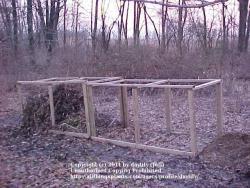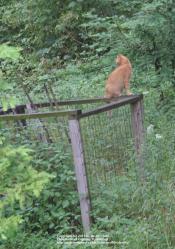I did find this really old photo taken a year or so after they were made. Sorry, it was taken a long time ago with an old digital camera when they didn't take high megapixel images.
These are two bins set together. Each one has two squares that are built together, sharing a common "wall" in the center. I had two made, and they are sitting side by side, so it looks like four bins, but by the plans, it is actually two. I know that is confusing! The cross bar at the top in front is fastened with a wing nut on one side, so you can open it for easy access. Keeping it closed keeps the individual bin square and from bowing.
The idea is that you put stuff in the bin on one side, then turn it into the next bin. My elderly Mom lives with me, and she can't get the idea of that. She just dumps stuff into what ever bin she is standing in front of. So all of them had some amount of stuff in them at one point.

I can see where the system would have worked great. I could have started on the left, then by the time the compost would have been in the right side, it would have been usable.

Instead, I had four bins of half usable stuff with new material on top all the time. I gave up on turning it. When I needed some, I just tried to dig some from around the bottom.
I live out where a big system like this is not a problem. Now, all these years later, weeds have grown up around it, and since I don't use it as much as I did, weeds are growing in it too. But, no one sees it. The second photo is the one with one of my garden cats sitting on it. It was a few years later. You can see what it looks like after it has weathered. It is a little blurry because I was using a telephoto at full range.
I did locate the book. It is called The New Victory Garden, by Bob Thomson. I could have sworn it was by Crockett!
https://www.amazon.com/dp/0316843369/



